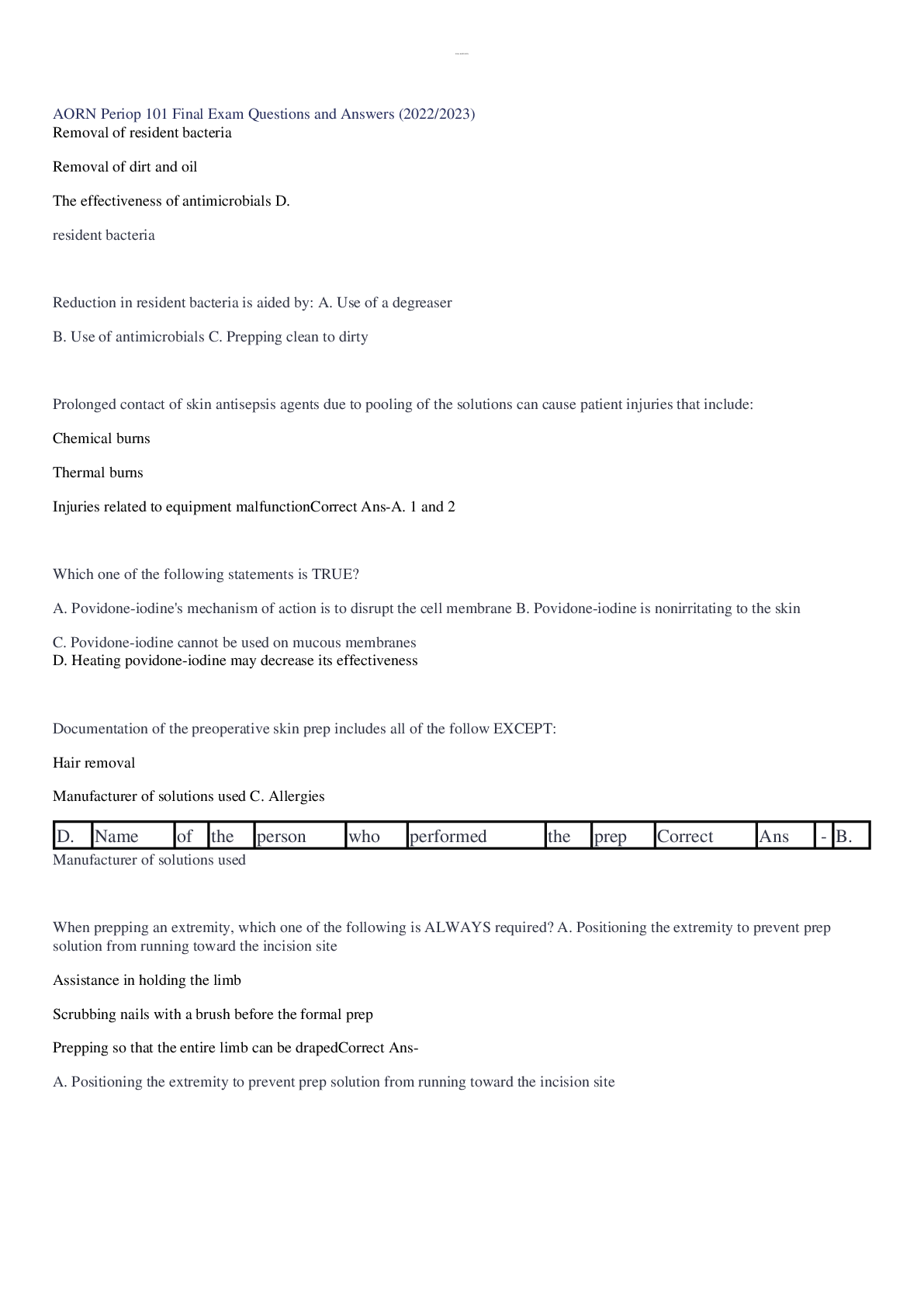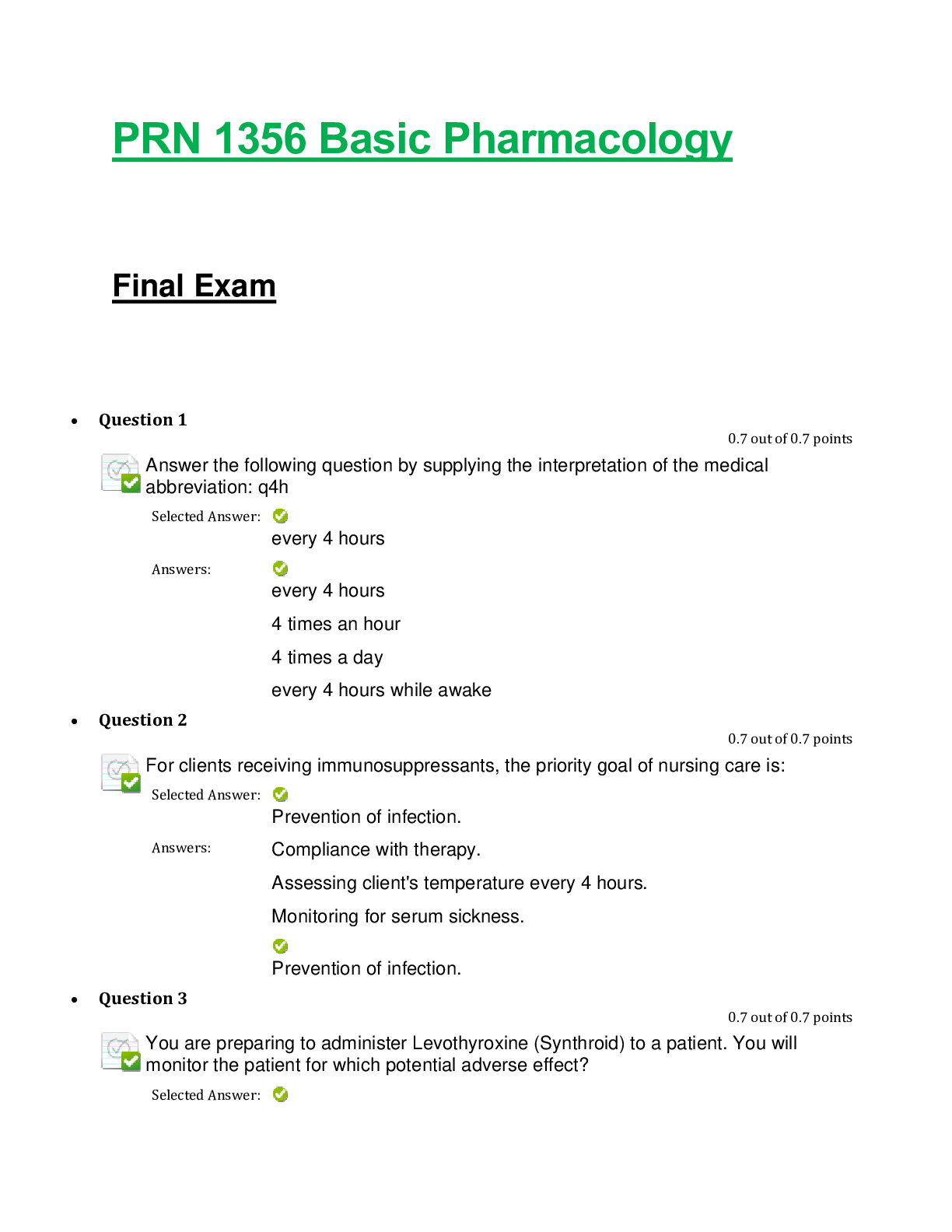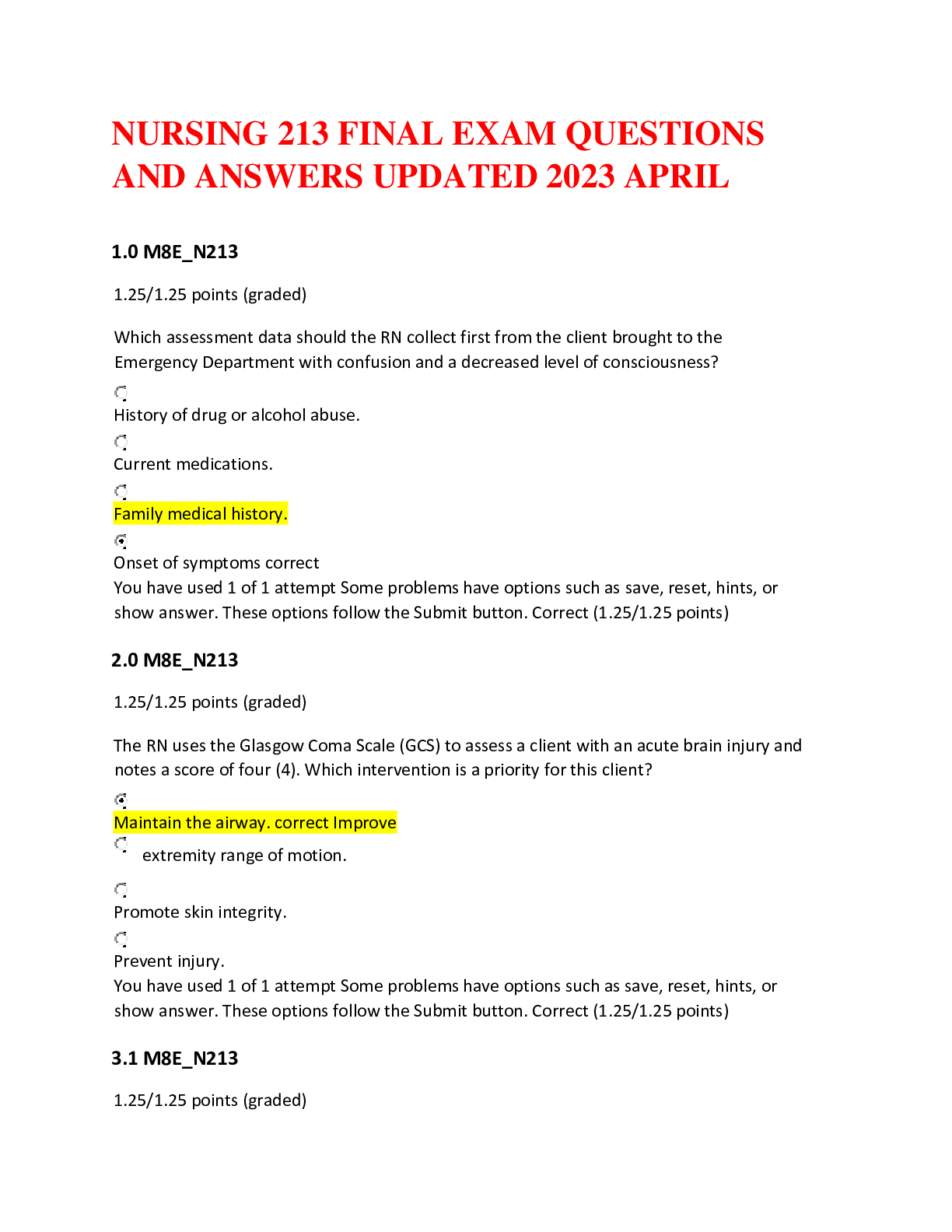NUR 2790 Final Exam Questions And Answers( Complete Solution Rated A)
Document Content and Description Below
Final Exam Questions (NUR 2790) CHAPTER 51: CARE OF PATIENTS WITH MUSCULOSKELETAL TRAUMA (30% OF FINAL EXAM) MULTIPLE CHOICE 1. A nurse assesses a client with a fracture who is being treated with ... skeletal traction. Which assessment should alert the nurse to urgently contact the health provider? a. Blood pressure increases to 130/86 mm Hg b. Traction weights are resting on the floor c. Oozing of clear fluid is noted at the pin site d. Capillary refill is less than 3 seconds ANS: B The immediate action of the nurse should be to reapply the weights to give traction to the fracture. The health care provider must be notified that the weights were lying on the floor, and the client should be realigned in bed. The clients blood pressure is slightly elevated; this could be related to pain and muscle spasms resulting from lack of pressure to reduce the fracture. Oozing of clear fluid is normal, as is the capillary refill time. Weights should not be removed without a prescription. They should not be lifted manually or allowed to rest on the floor. Weights should be freely hanging at all times. Inspect the skin Q8H for S/S of irritation or inflammation. Remove the belt or boot that is used for skin traction Q8H to inspect under the device. 2. A nurse coordinates care for a client with a wet plaster cast. Which statement should the nurse include when delegating care for this client to an unlicensed assistive personnel (UAP)? a. Assess distal pulses for potential compartment syndrome. b. Turn the client every 3 to 4 hours to promote cast drying. c. Use a cloth-covered pillow to elevate the clients leg. d. Handle the cast with your fingertips to prevent indentations. ANS: C When delegating care to a UAP for a client with a wet plaster cast, the UAP should be directed to ensure that the extremity is elevated on a cloth pillow instead of a plastic pillow to promote drying. The client should be assessed for impaired arterial circulation, a complication of compartment syndrome; however, the nurse should not delegate assessments to a UAP. The client should be turned every 1 to 2 hours to allow air to circulate and dry all parts of the cast. Providers should handle the cast with the palms of the hands to prevent indentations. 3. A nurse obtains the health history of a client with a fractured femur. Which factor identified in the clients history should the nurse recognize as an aspect that may impede healing of the fracture? a. Sedentary lifestyle b. A 30 pack-year smoking history c. Prescribed oral contraceptives d. Pagets disease ANS: D Pagets disease and bone cancer can cause pathologic fractures such as a fractured femur that do not achieve total healing. The other factors do not impede healing but may cause other health risks. Causes of Pathological Fractures: • Osteogenesis imperfecta • Rickets • Osteomalacia • Osteoporosis • Hyperparathyroidism • Cushing’s syndrome • Paget’s disease: a chronic form of osteitis (osteitis deformans) of unknown cause affecting older people, causing thickening and hypertrophy (enlargement) of the long bones and deformity of the flat bones • Neoplasms • Cystic bone disease • Primary benign bone tumor • Primary malignant bone tumor • Infection • Irradiation 4. An emergency department nurse cares for a client who sustained a crush injury to the right lower leg. The client reports numbness and tingling in the affected leg. Which action should the nurse take first? a. Assess the pedal pulses. b. Apply oxygen by nasal cannula. c. Increase the IV flow rate. d. Loosen the traction. ANS: A These symptoms represent early warning signs of acute compartment syndrome. In acute compartment syndrome, sensory deficits such as paresthesias precede changes in vascular or motor signs. If the nurse finds a decrease in pedal pulses, the health care provider should be notified as soon as possible. Vital signs need to be obtained to determine if oxygen and intravenous fluids are necessary. Traction, if implemented, should never be loosened without a providers prescription. Acute Compartment Syndrome: condition in which increased pressure within one or more compartments reduces circulation to the area (commonly in the lower leg tibial fractures and forearm) • Can begin 6 to 8 hrs after an injury or take up to 2 days to appear 5. A nurse assesses an older adult client who was admitted 2 days ago with a fractured hip. The nurse notes that the client is confused and restless. The clients vital signs are heart rate 98 beats/min, respiratory rate 32 breaths/min, blood pressure 132/78 mm Hg, and SpO2 88%. Which action should the nurse take first? a. Administer oxygen via nasal cannula. b. Re-position to a high-Fowlers position. c. Increase the intravenous flow rate. d. Assess response to pain medications. ANS: A The client is at high risk for a fat embolism and has some of the clinical manifestations of altered mental status and dyspnea. Although this is a life-threatening emergency, the nurse should take the time to administer oxygen first and then notify the health care provider. Oxygen administration can reduce the risk for cerebral damage from hypoxia. The nurse would not restrain a client who is confused without further assessment and orders. Sitting the client in a high-Fowlers position will not decrease hypoxia related to a fat embolism. The IV rate is not related. Pain medication most likely would not cause the client to be restless. Fat Embolism Syndrome (FES): a fracture complication in which fat globules are released from the yellow bone marrow into the bloodstream within 12 to 48 hrs after an injury • Hip fracture patients are at highest risk (24 to 72 hrs after injury or surgery) • 95% of FE come from the long bones • May be misdiagnosed as a PE from a blood clot • Early S/S: hypoxemia, dyspnea, tachypnea • Later S/S: headache, lethargy, agitation, confusion, decreased LOC, seizures, vision changes, retinal hemorrhage, mild thrombocytopenia • Last S/S: petechiae (macular, measles-like rash) classic manifestation • Treatment: bedrest, gentle handling, oxygen, IV hydration, steroid therapy, fracture immobilization 6. A trauma nurse cares for several clients with fractures. Which client should the nurse identify as at highest risk for developing deep vein thrombosis? a. An 18-year-old male athlete with a fractured clavicle b. A 36-year old female with type 2 diabetes and fractured ribs c. A 55-year-old woman prescribed aspirin for rheumatoid arthritis d. A 74-year-old man who smokes and has a fractured pelvis ANS: D Deep vein thrombosis (DVT) as a complication with bone fractures occurs more often when fractures are sustained in the lower extremities and the client has additional risk factors for thrombus formation. Other risk factors include obesity, smoking, oral contraceptives, previous thrombus events, advanced age, venous stasis (stasis of blood caused by venous congestion), prolonged immobility, surgical procedure longer than 30 mins, cancer or chemotherapy, and heart disease. The other clients do not have risk factors for DVT. 7. A nurse delegates care of a client in traction to an unlicensed assistive personnel (UAP). Which statement should the nurse include when delegating hygiene care for this client? a. Remove the traction when re-positioning the client. b. Inspect the clients skin when performing a bed bath. c. Provide pin care by using alcohol wipes to clean the sites. d. Ensure that the weights remain freely hanging at all times. ANS: D Traction weights should be freely hanging at all times. They should not be lifted manually or allowed to rest on the floor. The client should remain in traction during hygiene activities. The nurse should assess the clients skin and provide pin and wound care for a client who is in traction; this should not be delegated to the UAP. 8. A nurse notes crepitation when performing range-of-motion exercises on a client with a fractured left humerus. Which action should the nurse take next? a. Immobilize the left arm. b. Assess the clients distal pulse. c. Monitor for signs of infection. d. Administer prescribed steroids. ANS: A A grating sound heard when the affected part is moved is known as crepitation. This sound is created by bone fragments. Because bone fragments may be present, the nurse should immobilize the clients arm and tell the client not to move the arm. The grating sound does not indicate circulation impairment or infection. Steroids would not be indicated. 9. A nurse reviews prescriptions for an 82-year-old client with a fractured left hip. Which prescription should alert the nurse to contact the provider and express concerns for client safety? a. Meperidine (Demerol) 50 mg IV every 4 hours b. Patient-controlled analgesia (PCA) with morphine sulfate c. Percocet 2 tablets orally every 6 hours PRN for pain d. Ibuprofen elixir every 8 hours for first 2 days ANS: A Meperidine (Demerol) should not be used for older adults because it has toxic metabolites that can cause seizures. The nurse should question this prescription. The other prescriptions are appropriate for this clients pain management. The Beers Criteria for Potentially Inappropriate Medication Use in Older Adults (Beers List): guidelines to help improve the safety of prescribing medications for older adults • Meperidine (Demerol), opioid analgesic, appears on the Beers List (morphine is recommended instead) • PCA w/ morphine, fentanyl, or hydromorphone (Dilaudid) is recommended for pts w/ severe or multiple fractures • Common oral opioids for fracture pain include oxycodone, Percocet (oxycodone w/ acetaminophen), and Norco (hydrocodone w/ acetaminophen) • NSAIDs are given to decrease tissue inflammation but may slow bone healing • Strong analgesics should be given before dressing changes, after PT sessions, and at bedtime • Administer stool softener PRN for opioid-related constipation 10. A nurse is caring for a client who is recovering from an above-the-knee amputation. The client reports pain in the limb that was removed. How should the nurse respond? a. The pain you are feeling does not actually exist. b. This type of pain is common and will eventually go away. c. Would you like to learn how to use imagery to minimize your pain? d. How would you describe the pain that you are feeling? ANS: D The nurse should ask the client to rate the pain on a scale of 0 to 10 and describe how the pain feels. Although phantom limb pain is common, the nurse should not minimize the pain that the client is experiencing by stating that it does not exist or will eventually go away. Antiepileptic drugs and antispasmodics are used to treat neurologic pain and muscle spasms after amputation. Although imagery may assist the client, the nurse must assess the clients pain before determining the best action. 11. A home health nurse assesses a client with diabetes who has a new cast on the arm. The nurse notes the clients fingers are pale, cool, and slightly swollen. Which action should the nurse take first? a. Raise the arm above the level of the heart. b. Encourage range of motion. c. Apply heat to the affected hand. d. Bivalve the cast to decrease pressure. ANS: A Arm casts can impair circulation when the arm is in the dependent position. The nurse should immediately elevate the arm above the level of the heart, ensuring that the hand is above the elbow, and should re-assess the extremity in 15 minutes. If the fingers are warmer and less swollen, the cast is not too tight and adjustments do not need to be made, but a sling should be worn when the client is upright. Encouraging range of motion would not assist the client as much as elevating the arm. Heat would cause increased edema and should not be used. If the cast is confirmed to be too tight, it could be bivalved. 12. A nurse cares for a client who had a wrist cast applied 3 days ago. The client states, the cast is loose enough to slide off. How should the nurse respond? a. Keep your arm above the level of your heart. b. As your muscles atrophy, the cast is expected to loosen. c. I will wrap a bandage around the cast to prevent it from slipping. d. You need a new cast now that the swelling is decreased. ANS: D Often the surrounding soft tissues may be swollen considerably when the cast is initially applied. After the swelling has resolved, if the cast is loose enough to permit two or more fingers between the cast and the clients skin, the cast needs to be replaced. Elevating the arm will not solve the problem, and the clients muscles should not atrophy while in a cast for 6 weeks or less. An elastic bandage will not prevent slippage of the cast. 13. A nurse assesses a client with a pelvic fracture. Which assessment finding should the nurse identify as a complication of this injury? a. Hypertension b. Constipation c. Infection d. Hematuria ANS: D The pelvis is very vascular and close to major organs. Injury to the pelvis can cause integral damage that may manifest as blood in the urine (hematuria) or stool. The nurse should also assess for signs of hemorrhage and hypovolemic shock, which include hypotension and tachycardia. Constipation and infection are not complications of a pelvic fracture. 14. A nurse cares for a client placed in skeletal traction. The client asks, what is the primary purpose of this type of traction? How should the nurse respond? a. Skeletal traction will assist in realigning your fractured bone. b. This treatment will prevent future complications and back pain. c. Traction decreases muscle spasms that occur with a fracture. d. This type of traction minimizes damage as a result of fracture treatment. ANS: A Skeletal traction pins or screws are surgically inserted into the bone to aid in bone alignment. As a last resort, traction can be used to relieve pain, decrease muscle spasm, and prevent or correct deformity and tissue damage. These are not primary purposes of skeletal traction. 15. A nurse cares for a client in skeletal traction. The nurse notes that the skin around the clients pin sites is swollen, red, and crusty with dried drainage. Which action should the nurse take next? a. Request a prescription to decrease the traction weight. b. Apply an antibiotic ointment and a clean dressing. c. Cleanse the area, scrubbing off the crusty areas. d. Obtain a prescription to culture the drainage. ANS: D These clinical manifestations indicate inflammation and possible infection. Infected pin sites can lead to osteomyelitis and should be treated immediately. The nurse should obtain a culture and assess vital signs. The provider should be notified. By decreasing the traction weight, applying a new dressing, or cleansing the area, the infection cannot be significantly treated. A disadvantage of external fixation is an increased risk for pin-site infection. Pin-site infections can lead to osteomyelitis, which is serious and difficult to treat Osteomyelitis: inflammation of bone marrow, usually caused by infection in the long bones or spine 16. A nurse cares for a client recovering from an above-the-knee amputation of the right leg. The client reports pain in the right foot. Which prescribed medication should the nurse administer first? a. Intravenous morphine b. Oral acetaminophen c. Intravenous calcitonin d. Oral ibuprofen ANS: C The client is experiencing phantom limb pain, which usually manifests as intense burning, crushing, or cramping. IV infusions of calcitonin during the week after amputation can reduce phantom limb pain. Opioid analgesics such as morphine are not as effective for phantom limb pain as they are for residual limb pain (i.e., pain in the remaining portion of the limb). Oral acetaminophen and ibuprofen are not used in treating phantom limb pain. Calcitonin (Miacalcin): a hormone produced by the thyroid gland that treats hypercalcemia and reduces bone pain. Calcitonin inhibits reabsorption of calcium from the bone and increases the storage of calcium in the bone. Calcitonin lowers circulating levels of calcium by promoting the excretion of calcium and phosphate by the kidneys • Parathyroid Hormone (PTH): hormone produced by the parathyroid glands that has the opposite effect of calcitonin (i.e. increase renal reabsorption of calcium, promotes release of calcium from bones, increases serum calcium), treating hypocalcemia 17. A nurse plans care for a client who is recovering from a below-the-knee amputation of the left leg. Which intervention should the nurse include in this clients plan of care? a. Place pillows between the clients knees. b. Encourage range-of-motion exercises. c. Administer prophylactic antibiotics. d. Implement strict bedrest in a supine position. ANS: B Clients with a below-the-knee amputation should complete range-of-motion exercises to prevent flexion contractions and prepare for a prosthesis. A pillow may be used under the limb as support. Clients recovering from this type of amputation are at low risk for infection and should not be prescribed prophylactic antibiotics. The client should be encouraged to re-position, move, and exercise frequently, and therefore should not be restricted to bedrest. 18. An emergency department nurse triages a client with diabetes mellitus who has fractured her arm. Which action should the nurse take first? a. Remove the medical alert bracelet from the fractured arm. b. Immobilize the arm by splinting the fractured site. c. Place the client in a supine position with a warm blanket. d. Cover any open areas with a sterile dressing. ANS: A A clients medical alert bracelet should be removed from the fractured arm before the affected extremity swells. Immobilization, positioning, and dressing should occur after the bracelet is removed. Emergency Care of the Patient With an Extremity Fracture: • Assess ABCs and perform rapid head-to-toe assessment • Remove the patient's clothing (cut if necessary) to inspect the affected area, support the area above and below the injury, and do not remove shoes (can cause increased trauma) unless the foot or ankle is injured • Remove jewelry on the affected extremity in case of swelling (e.g. medical alert bracelet) • Apply direct pressure on the area if there is bleeding and pressure over the artery proximal to the fracture • Keep the patient warm and supine • Check CSM, temp, and color distal to the fracture (compare affected and unaffected limbs) • Immobilize the extremity by splinting above and below the fracture site (recheck circulation after splinting) • Cover any open areas with a dressing (preferably sterile) 19. A nurse assesses a client with a rotator cuff injury. Which finding should the nurse expect to assess? a. Inability to maintain adduction of the affected arm for more than 30 seconds b. Shoulder pain that is relieved with overhead stretches and at night c. Inability to initiate or maintain abduction of the affected arm at the shoulder d. Referred pain to the shoulder and arm opposite the affected shoulder ANS: C Clients with a rotator cuff tear are unable to initiate or maintain abduction of the affected arm at the shoulder. This is known as the drop arm test. The client should not have difficulty with adduction of the arm, nor experience referred pain to the opposite shoulder. Pain is usually more intense at night and with overhead activities. Rotator Cuff Injury: • Drop Arm Test: when the arm is abducted, he or she usually drops it because abduction cannot be maintained • Pain is more intense at night and with overhead activities • Partial-thickness tears are more painful than full-thickness tears, but full-thickness tears result in more weakness and loss of function • Muscle atrophy is commonly seen, and MOBILITY is reduced • Diagnosis is confirmed with x-rays, MRI, ultrasonography, and/or CT scans. 20. A nurse cares for a client with a fractured fibula. Which assessment should alert the nurse to take immediate action? a. Pain of 4 on a scale of 0 to 10 b. Numbness in the extremity c. Swollen extremity at the injury site d. Feeling cold while lying in bed ANS: B The client with numbness and/or tingling of the extremity may be displaying the first signs of acute compartment syndrome. This is an acute problem that requires immediate intervention because of possible decreased circulation. Moderate pain and swelling is an expected assessment after a fracture. These findings can be treated with comfort measures. Being cold can be treated with additional blankets or by increasing the temperature of the room. 21. After teaching a client with a fractured humerus, the nurse assesses the clients understanding. Which dietary choice demonstrates that the client correctly understands the nutrition needed to assist in healing the fracture? a. Baked fish with orange juice and a vitamin D supplement b. Bacon, lettuce, and tomato sandwich with a vitamin B supplement c. Vegetable lasagna with a green salad and a vitamin A supplement d. Roast beef with low-fat milk and a vitamin C supplement ANS: D The client with a healing fracture needs supplements of vitamins B and C and a high-protein, high-calorie diet. Milk for calcium supplementation and vitamin C supplementation are appropriate. Meat would increase protein in the diet that is necessary for bone healing. Fish, a sandwich, and vegetable lasagna would provide less protein. • Calcium, phosphorus, vitamin D (regulates the absorption of calcium), and protein (needed to bind calcium for use by the body, 50% of calcium is protein bound) are necessary for the production of new bone • Vitamin C and zinc are essential components in connective tissue repair • Inadequate protein or insufficient vitamin C or D in the diet slows bone and tissue healing 22. A nurse cares for an older adult client with multiple fractures. Which action should the nurse take to manage this clients pain? a. Meperidine (Demerol) injections every 4 hours around the clock b. Patient-controlled analgesia (PCA) pump with morphine c. Ibuprofen (Motrin) 600 mg orally every 4 hours PRN for pain d. Morphine 4 mg intravenous push every 2 hours PRN for pain ANS: B The older adult client should never be treated with meperidine because toxic metabolites can cause seizures. The client should be managed with a PCA pump to control pain best. Motrin most likely would not provide complete pain relief with multiple fractures. IV morphine PRN would not control pain as well as a pump that the client can control. 23. A phone triage nurse speaks with a client who has an arm cast. The client states, My arm feels really tight and puffy. How should the nurse respond? a. Elevate your arm on two pillows and get ice to apply to the cast. b. Continue to take ibuprofen (Motrin) until the swelling subsides. c. This is normal. A new cast will often feel a little tight for the first few days. d. Please come to the clinic today to have your arm checked by the provider. ANS: D Puffy fingers and a feeling of tightness from the cast may indicate the development of compartment syndrome. The client should come to the clinic that day to be evaluated by the provider because delay of treatment can cause permanent damage to the extremity. Ice and ibuprofen are acceptable actions, but checking the cast is the priority because it ensures client safety. The nurse should not reassure the client that this is normal. • Six P’s of Compartment Syndrome: Pain, Pressure, Paralysis, Paresthesia, Pallor, and Pulselessness 24. A nurse cares for a client who had a long-leg cast applied last week. The client states, I cannot seem to catch my breath and I feel a bit light-headed. Which action should the nurse take next? a. Auscultate the clients lung fields anteriorly and posteriorly. b. Administer oxygen to keep saturations greater than 92%. c. Check the clients blood glucose level. d. Ask the client to take deep breaths. ANS: B The clients symptoms are consistent with the development of pulmonary embolism caused by leg immobility in the long cast. The nurse should check the clients pulse oximetry reading and provide oxygen to keep saturations greater than 92%. Auscultating lung fields, checking blood glucose level, or deep breathing will not assist this client. 25. A nurse cares for an older adult client who is recovering from a leg amputation surgery. The client states, I dont want to live with only one leg. I should have died during the surgery. How should the nurse respond? a. Your vital signs are good, and you are doing just fine right now. b. Your children are waiting outside. Do you want them to grow up without a father? c. This is a big change for you. What support system do you have to help you cope? d. You will be able to do some of the same things as before you became disabled. ANS: C The client feels like less of a person following the amputation. The nurse should help the client to identify coping mechanisms that have worked in the past and current support systems to assist the client with coping. The nurse should not ignore the clients feelings by focusing on vital signs. The nurse should not try to make the client feel guilty by alluding to family members. The nurse should not refer to the client as being disabled as this labels the client and may fuel the clients poor body image. 26. After teaching a client who is recovering from a vertebroplasty, the nurse assesses the clients understanding. Which statement by the client indicates a need for additional teaching? a. I can drive myself home after the procedure. b. I will monitor the puncture site for signs of infection. c. I can start walking tomorrow and increase my activity slowly. d. I will remove the dressing the day after discharge. ANS: A Before discharge, a client who has a vertebroplasty should be taught to avoid driving or operating machinery for the first 24 hours. The client should monitor the puncture site for signs of infection. Usual activities can resume slowly, including walking and slowly increasing activity over the next few days. The client should keep the dressing dry and remove it the next day. Surgical Procedures for VCF: • Vertebroplasty: plastic surgical repair of a vertebra, typically with an injection of methyl methacrylate (“bone cement”) • Kyphoplasty: treatment for a vertebral compression fracture (VCF) in which a collapsed vertebral body is restored to its normal size and shape with a balloon, followed by the injection of bone cement to maintain the bone's shape and strength Post-Op Care: • Place supine for 1 to 2 hrs • Neurologic assessment and monitor V/S frequently • Apply ice to puncture site PRN to relieve pain • Assess pain level and compare to pre-op pain level (give mild analgesic PRN) • Monitor for complications (e.g., bleeding from puncture site, SOB, etc.) • Assist with ambulation Discharge Instructions: • Avoid driving or machinery for 24 hrs • Monitor for signs of infection (e.g., erythema, pain, swelling, drainage) • Keep dressing dry and remove the next day • Begin usual activities (e.g., walking) the next day, and increase activity slowly over next few days 27. A nurse plans care for a client who is prescribed skeletal traction. Which intervention should the nurse include in this plan of care to decrease the clients risk for infection? a. Wash the traction lines and sockets once a day. b. Release traction tension for 30 minutes twice a day. c. Do not place the traction weights on the floor. d. Schedule for pin care to be provided every shift. ANS: D To decrease the risk for infection in a client with skeletal traction of external fixation, the nurse should provide routine pin care and assess manifestations of infection at the pin sites every shift. The traction lines and sockets are external and do not come in contact with the clients skin; these do not need to be washed. Although traction weights should not be removed or released for any period of time without a prescription, or placed on the floor, this does not decrease the risk for infection. MULTIPLE RESPONSE 1. A nurse teaches a client with a fractured tibia about external fixation. Which advantages of external fixation for the immobilization of fractures should the nurse share with the client? (Select all that apply.) a. It leads to minimal blood loss. b. It allows for early ambulation. c. It decreases the risk of infection. d. It increases blood supply to tissues. e. It promotes healing. ANS: A, B, E External fixation is a system in which pins or wires are inserted through the skin and bone and then connected to a ridged external frame. With external fixation, blood loss is less than with internal fixation, but the risk for infection is much higher. The device allows early ambulation and exercise, maintains alignment, stabilizes the fracture site, and promotes healing. The device does not increase blood supply to the tissues. The nurse should assess for distal circulation, movement, and sensation, which can be disturbed by fracture injuries and treatments. Advantage (over other surgical interventions): • Minimal blood loss compared with internal fixation • Allows for early ambulation and exercise of the affected body part while relieving pain • Maintains alignment in closed fractures that will not maintain position in a cast • Stabilizes comminuted fractures that require bone grafting • Permits easy access to the wound in open fractures, while the bone heals Disadvantage: • Increased risk for pin-site infection • Pin-site infections can lead to osteomyelitis, which is serious and difficult to treat 2. An emergency nurse assesses a client who is admitted with a pelvic fracture. Which assessments should the nurse monitor to prevent a complication of this injury? (Select all that apply.) a. Temperature b. Urinary output c. Blood pressure d. Pupil reaction e. Skin color ANS: B, C, E With a pelvic fracture, internal organ damage may result in bleeding and hypovolemic shock. The nurse monitors the clients heart rate, blood pressure, urine output, skin color, and level of consciousness frequently to determine whether shock is manifesting. It is important to monitor the urine for blood to assess whether the urinary system has been damaged with the pelvic fracture. Changes in temperature and pupil reactions are not directly associated with hypovolemic shock. Temperature changes are usually associated with hypo- or hyperthermia or infectious processes. Pupillary changes occur with brain injuries, bleeds, or neurovascular accidents. 3. A nurse cares for a client with a fracture injury. Twenty minutes after an opioid pain medication is administered, the client reports pain in the site of the fracture. Which actions should the nurse take? (Select all that apply.) a. Administer additional opioids as prescribed. b. Elevate the extremity on pillows. c. Apply ice to the fracture site. d. Place a heating pad at the site of the injury. e. Keep the extremity in a dependent position. ANS: A, B, C The client with a new fracture likely has edema; elevating the extremity and applying ice probably will help in decreasing pain. Administration of an additional opioid within the dosage guidelines may be ordered. Heat will increase edema and may increase pain. Dependent positioning will also increase edema. 4. A nurse plans care for a client who is recovering from open reduction and internal fixation (ORIF) surgery for a right hip fracture. Which interventions should the nurse include in this clients plan of care? (Select all that apply.) a. Elevate heels off the bed with a pillow. b. Ambulate the client on the first postoperative day. c. Push the clients patient-controlled analgesia button. d. Re-position the client every 2 hours. e. Use pillows to encourage subluxation (dislocation) of the hip. ANS: A, B, D Postoperative care for a client who has ORIF of the hip includes elevating the clients heels off the bed and re- positioning every 2 hours to prevent pressure and skin breakdown. It also includes ambulating the client on the first postoperative day, and using pillows or an abduction pillow to prevent subluxation of the hip. The nurse should teach the client to use the patient-controlled analgesia pump, but the nurse should never push the button for the client. Open Reduction w/ Internal Fixation (ORIF): • Open Reduction: the realignment of bone segments under direct visualization through an incision • Internal Fixation: the use of metal pins, screws, rods, plates, or prostheses to immobilize the fracture during healing • Common method of reducing and immobilizing a fracture • Permits early mobility • Allows surgeon to directly view the fracture site • Contraindicated in active infections, fractures w/ multiple bone fragments, or in severe osteoporosis 5. A nurse assesses a client with a cast for potential compartment syndrome. Which clinical manifestations are correctly paired with the physiologic changes of compartment syndrome? (Select all that apply.) a. Edema Increased capillary permeability b. Pallor Increased blood blow to the area c. Unequal pulses Increased production of lactic acid d. Cyanosis Anaerobic metabolism e. Tingling A release of histamine ANS: A, C, D Clinical manifestations of compartment syndrome are caused by several physiologic changes. Edema is caused by increased capillary permeability, release of histamine, decreased tissue perfusion, and vasodilation. Unequal pulses are caused by an increased production of lactic acid. Cyanosis is caused by anaerobic metabolism. Pallor is caused by decreased oxygen to tissues, and tingling is caused by increased tissue pressure. PHYSIOLOGIC CHANGE CLINICAL FINDINGS Increased compartment pressure No change Increased capillary permeability Edema Release of histamine Increased edema Increased blood flow to area Pulses present & Pink tissue Pressure on nerve endings Pain Increased tissue pressure Referred pain to compartment Decreased tissue perfusion Increased edema Decreased oxygen to tissues Pallor Increased production of lactic acid Unequal pulses & Flexed posture Anaerobic metabolism Cyanosis Vasodilation Increased edema Increased blood flow Tense muscle swelling Increased tissue pressure Tingling & Numbness Increased edema Paresthesia Muscle ischemia Severe pain unrelieved by drugs Tissue necrosis Paresis/paralysis 6. A nurse teaches a client who is at risk for carpal tunnel syndrome. Which health promotion activities should the nurse include in this clients teaching? (Select all that apply.) a. Frequently assess the ergonomics of the equipment being used. b. Take breaks to stretch fingers and wrists during working hours. c. Do not participate in activities that require repetitive actions. d. Take ibuprofen (Motrin) to decrease pain and swelling in wrists. e. Adjust chair height to allow for good posture. ANS: A, B, E Health promotion activities to prevent carpal tunnel syndrome include assessing the ergonomics of the equipment being used, taking breaks to stretch fingers and wrists during working hours, and adjusting chair height to allow for good posture. The client should be allowed to participate in activities that require repetitive actions as long as precautions are taken to promote health. Pain medications are not part of health promotion activities. Carpal tunnel syndrome (CTS): a common condition in which the median nerve in the wrist becomes compressed, causing pain and numbness • Most common type of repetitive stress injury (RSI) • Health Promotion Activities to Prevent Carpal Tunnel Syndrome: o Become familiar w/ laws regarding workplace requirements to prevent RSIs o Assess the ergonomics of the equipment being used: ▪ Specially designed wrist rest devices ▪ Geometrically designed computer keyboards ▪ Chair height that allows good posture o Take regular short breaks away from activities that cause RSIs (e.g., working at computers) o Stretch fingers and wrists frequently during work hours o Stay as relaxed as possible when using equipment that causes RSIs 7. A nurse teaches a client about prosthesis care after amputation. Which statements should the nurse include in this clients teaching? (Select all that apply.) a. The device has been custom made specifically for you. b. Your prosthetic is good for work but not for exercising. c. A prosthetist will clean your inserts for you each month. d. Make sure that you wear the correct liners with your prosthetic. e. I have scheduled a follow-up appointment for you. ANS: A, D, E A client with a new prosthetic should be taught that the prosthetic device is custom made for the client, taking into account the clients level of amputation, lifestyle (including exercise preferences), and occupation. In collaboration with a prosthetist, the client should be taught proper techniques for cleansing the sockets and inserts, wearing the correct liners, and assessing shoe wear. Follow-up care and appointments are important for ongoing assessment. CHAPTER 60: MUSCULOSKELETAL TRAUMA: NURSING MANAGEMENT OLD BOOK MULTIPLE CHOICE 1. A client tells the nurse that he has pain, swelling, fatigue, and numbness of his hands. The nurse should assess the client for which of the following occupations? a. Retail store clerk b. Lifeguard c. Computer keyboard operator d. Bus driver ANS: C Some occupations, sports, and tasks can create repetitive motion injuries or cumulative trauma. A computer keyboard operator is an occupation with a high incidence of overuse syndrome. 2. A client who plays baseball on the weekends is experiencing an arm injury. The nurse realizes this client needs to be evaluated for: a. a rotator cuff tear. b. lateral epicondylitis. c. dislocation of the shoulder. d. patellar tendinopathy. ANS: A A rotator cuff tear can be caused by extensive overhead movements found in sports and activities such baseball, softball, tennis, swimming, and volleyball. A dislocation of the shoulder is most commonly caused by a fall on an outstretched hand and arm. Lateral epicondylitis, or tennis elbow, is an overuse injury that involves the extensor/supinator muscles that attach to the distal humerus. Patellar tendinopathy, also known as jumper’s knee, is seen in athletes who participate in activities that require a lot of jumping such as basketball. Jumper’s Knee = Patellar Tendinopathy Tennis Elbow = Lateral Epicondylitis 3. A client, diagnosed with an ankle sprain, is prescribed ibuprofen to control pain and inflammation. What instruction should the client receive concerning this medication? a. “Bleeding is not a problem with this medication.” b. “Take on an empty stomach to maximize its effect.” c. “Take with food to minimize gastrointestinal irritation.” d. “Wear sunscreen if outside to prevent a burn.” ANS: C Ibuprofen is a nonsteroidal anti-inflammatory drug (NSAID). NSAIDs should be taken with food to minimize gastrointestinal irritation. Ibuprofen does not increase photosensitivity; however, bleeding can be a problem when taking ibuprofen. 4. A client, experiencing a fractured arm, asks the nurse why the splint is being applied. Which of the following should the nurse respond to this client? a. “It reduces the need for a cast.” b. “It reduces bleeding, swelling and pain.” c. “It prevents the need for surgery.” d. “It immobilizes the muscles and joints.” ANS: B Splinting of a fractured extremity minimizes bleeding, edema, and pain. Splinting does not reduce the need for a cast nor prevent the need for surgery. A cast immobilizes the muscles and joints. 5. A client has had a cast applied to immobilize a right ulnar fracture. Which of the following nursing interventions is most important? a. Calling physical therapy for a sling b. Checking capillary refill time c. Giving pain medication d. Starting discharge teaching ANS: B Checking the capillary refill time determines that circulation is not compromised. The other options can be completed after ensuring that circulation to the site is still adequate. 6. A client with a right arm cast is experiencing signs of a serious complication. Which of the following would cause the nurse the most concern? a. Capillary refill time less than 3 seconds b. Finger movement c. Itching under the cast d. Severe pain to the right arm continues after receiving pain medication ANS: D Severe pain that continues after receiving pain medication would be considered as being disproportionate to the injury, can be a sign of compartment syndrome, and should be immediately reported. The other options are expected assessment findings for a client with a cast. 7. A client is unable to pass the chair raise test. The nurse realizes this client is experiencing: a. carpal tunnel syndrome. b. rotator cuff tear. c. fractured arm. d. lateral epicondylitis. ANS: D The chair raise test examines the client’s ability to grip and lift. The client stands behind a chair and places the hands on the chair back. The client then attempts to raise the chair. If pain is experienced over the lateral elbows, lateral epicondylitis (Tennis Elbow) may be present. The chair raise test is not used to diagnose carpal tunnel syndrome, rotator cuff tear, or a fractured arm. 8. A client has been wearing a splint for carpal tunnel syndrome for 7 weeks. The nurse realizes that which of the following would be the next course of treatment for this client? a. Surgery b. Exercises c. Corticosteroid injection d. Casting ANS: C If after 2 to 7 weeks of conservative treatment the carpal tunnel syndrome symptoms do not improve, corticosteroid injection is recommended. Surgery is not recommended until after corticosteroid injections have been tried. Exercises are implemented with the use of the splint. Casting is not a treatment for carpal tunnel syndrome. NSAIDs are the most commonly prescribed drugs for the relief of pain and inflammation, if present. In addition to or instead of systemic medications, the physician may inject corticosteroids directly into the carpal tunnel. If the patient responds to the injection, several additional weekly or monthly injections are given. Teach him or her to take NSAIDs with or after meals to reduce gastric irritation. 9. The nurse is planning care for a client recovering from a meniscal injury. Which of the following should be included as strategies to avoid future injuries? a. Avoid hamstring muscle exercises. b. Stretch before and after exercise. c. Wear similar shoes for all activities. d. Avoid skiing. ANS: B Strategies to prevent future meniscal injuries include having strong thigh and hamstring muscles; stretching before and after exercise; wearing shoes that fit and are appropriate for the activity; and when skiing, having bindings that release the skis with a fall. Meniscus Tear: damage to knee cartilage commonly caused by sports or other trauma • Tx: RICE, bracing, splinting, NSAIDs, arthroscopic surgery • RICE: Rest, Ice, Compression, Elevate management of acute soft tissue injuries 10. A client with an ankle sprain is instructed to follow RICE. Which of the following should the nurse instruct the client regarding this process? a. “Maintain your normal level of activity.” b. “Apply ice to the ankle once a day.” c. “Apply an elastic bandage to the site.” d. “Elevate the extremity every day for 20 to 30 minutes.” ANS: C The nurse should instruct the client to use crutches to allow for the rest of the ankle joint and relieve pain; apply ice for 20 to 30 minutes 3 to 4 times a day; apply an elastic bandage to the site; and elevate the ankle for the first 48 hours after the injury. • Rest the injured part; immobilize the joint above and below the injury by applying a splint if needed. • Apply ice intermittently for the first 24 to 48 hours (heat may be used thereafter). • Use compression for the first 24 to 48 hours (e.g., elastic wrap). • Elevate the affected limb to decrease swelling. 11. The nurse is evaluating the effectiveness of care for a client recovering from an injured Achilles tendon. Which of the following would indicate that care has been effective? a. Client states steroid injections will be helpful to reduce the amount of pain. b. Client plans to participate in rehabilitation for 5 to 6 months after the injury. c. Client resumes sports activities as soon as possible. d. Client uses heat to decrease the inflammation and swelling from the injury. ANS: B Evidence that care has been effective for a client recovering from an injured Achilles tendon would be that the client plans to participate in rehabilitation for 5 to 6 months after the injury. Steroid injections are not used for this type of injury. Sports activities should be avoided until the injury has healed and rehabilitation is completed. Cryotherapy, not heat, is used to decrease the inflammation and swelling from the injury. 12. The nurse is instructing a client on ways to prevent the onset of stress fractures. Which of the following should be included in these instructions? a. Avoid overtraining b. Increase intensity of training 10% each day c. Limit warm up exercises d. Avoid shock absorbing footwear ANS: A Interventions to prevent the onset of stress fractures include: avoid overtraining; gradually increase the intensity of workouts by 10% each week; perform adequate warm up exercises; and use shock absorbing footwear and insoles. 13. The nurse suspects a client, recovering from hip replacement surgery, is experiencing an infection when which of the following is assessed? a. Client using crutches to ambulate b. Blood pressure 110/68 mmHg c. Pain with movement d. Foot intact to sensation and motion ANS: C Evidence of an infection in the joint of a client recovering from hip replacement surgery includes erythema, edema, drainage, and tenderness over the joint; persistent pain in the joint with movement; and narrowing of the joint space upon x-ray. Using crutches to ambulate would not indicate an infection in the operative site. A blood pressure of 110/68 mmHg is within normal limits. The foot being intact to sensation and motion would indicate the limb is receiving sufficient blood and oxygenation. MULTIPLE RESPONSE 1. The nurse is concerned that a client is demonstrating signs of compartment syndrome. Which of the following is considered a classical symptom of this disorder? (Select all that apply.) a. Pain b. Paraplegia c. Paresthesia d. Pink e. Pressure f. Pulselessness ANS: A, C, E, F The classical symptoms of the six P’s of compartment syndrome are pain, paresthesia, paresis, pressure, pallor, and pulselessness. The pink color and paraplegia are not part of the classic P’s. 2. A client is diagnosed with a pathological fracture. For which of the following disease processes should the nurse assess the client? (Select all that apply.) a. Cushing’s syndrome b. Osteomalacia c. Paget’s disease d. Heart failure e. Diabetes mellitus f. Chronic obstructive pulmonary disease ANS: A, B, C Causes of pathological fractures include Cushing’s syndrome, osteomalacia, and Paget’s disease. Pathological fractures are not associated with heart failure, diabetes mellitus, or chronic obstructive pulmonary disease. Cushing’s Syndrome: symptoms resulting from prolonged exposure to cortisol (hypercortisolism) • Caused by endogenous sources (ACTH secreting pituitary tumors or excessive secretions of cortisol) or exogenous sources (corticosteroid Rx for inflammatory or immune conditions) • Adrenocorticotropic hormone (ACTH) is secreted by the anterior pituitary gland and signals the adrenal cortex to secrete cortisol 3. A client, recovering from a fractured pelvis, begins to have dyspnea and restlessness. The nurse is concerned that the client is experiencing a fat emboli when which of the following are assessed? (Select all that apply.) a. Upper body petechiae b. Cough c. Protein in the urine d. Seizures e. Temperature 102°F f. Elevated blood glucose level ANS: A, D, E Symptoms of fat emboli include hypoxemia, mental status changes, petechiae, seizures, and a body temperature greater than 101.3°F. Cough, protein in the urine, and elevated blood glucose level are not symptoms of fat emboli. 4. The nurse is assessing a client recovering from abdominal surgery for the development of a deep vein thrombosis. Which of the following would indicate that the client is experiencing this disorder? (Select all that apply.) a. Pain and tenderness of the lower extremity b. Red area on a limb that is warm to the touch c. Unexplained dyspnea d. Chest pain e. Hemoptysis f. Drop in blood pressure ANS: A, B, C, D, E The client may describe limb pain as aching, cramping, sharp, dull, severe, or mild. Tenderness and pain of the lower extremity and a red area that is warm to touch are also indications that the disorder is present. Other signs and symptoms include unexplained dyspnea, chest pain, and hemoptysis. A drop in blood pressure is not an indication for a deep vein thrombosis. 5. The nurse is planning care for a client recovering from an amputation. Which of the following should be included in this plan of care? (Select all that apply.) a. Provide pain medication 30 minutes before stump care. b. Wash the stump daily with mild soap and warm water. c. Allow the stump to dry open to the air for 10 minutes after washing. d. Avoid massaging the stump. e. Elevate the stump on a pillow. f. Lie prone 10 to 20 minutes every day. ANS: A, B, C, F Care of the client recovering from an amputation includes providing pain medication 30 minutes before stump care; washing the stump daily with mild soap and warm water; allowing the stump to dry open to the air for 10 minutes after washing; massaging the stump daily; avoiding elevating the stump on a pillow to prevent contractures; and lying prone for 10 to 20 minutes every day to prevent contractures. Topics to Review Cancer: Chapters 21 and 22 + dump sheets on various types • Thrombocytopenia/neutropenia/anemia • Primary/secondary prevention • Staging/grading • Chemo/radiation care End of Life: Chapt. 7 • Care beliefs • Hospice vs. palliative care. Disaster/emergency management: chapt. 10 • ABCs • Primary/secondary survey • Priority of care • Triage (standard vs. mass casualty Burns: Chapt. 26 • Parkland formula • Rule of 9’s • Inhalation injuries-s/s and those at risk • Types of burns-description • Assessment/complications Lower Airway: Chapter 32 • Basic overview of ventilators-nursing management/trouble shooting • extubation • Know types and settings (esp. PEEP-complications) • Communication with patient on ventilator • Suctioning (lab) • PE/ARDS/pneumonia Dysrhythmia’s: Chapter 34 • Be able to interpret rhythm strips and treat. • BLS • Know measurements Shock: Chapter 37 + handouts • Types-causes • Phases • Patho ACS: Chapt 38 • Angina’s • What to do if a patient develops chest pain • Meds (nitro/morphine/betablockers/antiplatelet’s/anticoagulants) • STEMI vs. NONSTEMI • tPA-thrombolytics • modifiable and non-modifiable risk factors (education) Endocrine: Chapt. 61-62 • General overview/symptoms/hormone affected Renal: Chapt. 68 • Acute-causes • Electrolytes • Transplantation • Chronic management • Hemo vs. peritoneal diaysis Liver, Biliary and Pancreas: Chapt 8 and 59 • Hepatitis types-mode of transition • Pancreas-priority of care • Gallbladder-sympoms/ Neuro: Chapt. 45 • Glasgow coma scale • CSF • ICP • Communicating with the stroke patient • Right vs. left stroke • tPA-thrombolytics • Stroke-who’s at risk • Nursing care Musculoskeletal: Chapt. 51 • Nursing care post amputation (Pages 1050-1056) • Phantom limb pain (Pages 1051-1053) • Common complications-fractures (Pages 1046-1050) • RICE • Casts/external fixator care & benefits (Pages 1038) • External fixations benefits: (Page 1042) • Fractures (types/nursing care/assessment/complications) (Page 1046) • Post op care ORIF (Page 1042-1043) Concepts: • Perfusion • Gas exchange • Intracranial regulation [Show More]
Last updated: 1 year ago
Preview 1 out of 12 pages
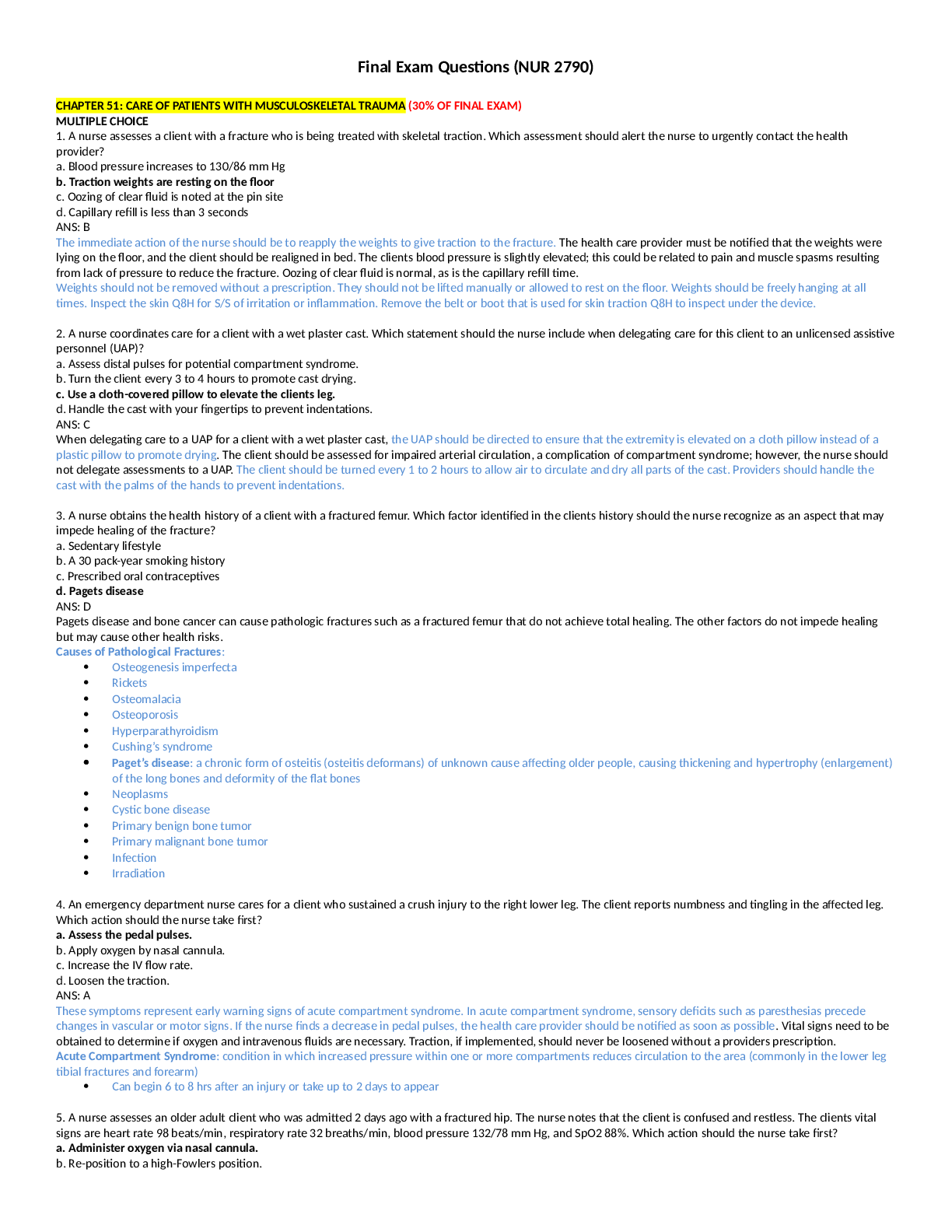
Reviews( 0 )
Document information
Connected school, study & course
About the document
Uploaded On
Jun 14, 2021
Number of pages
12
Written in
Additional information
This document has been written for:
Uploaded
Jun 14, 2021
Downloads
0
Views
34

.png)
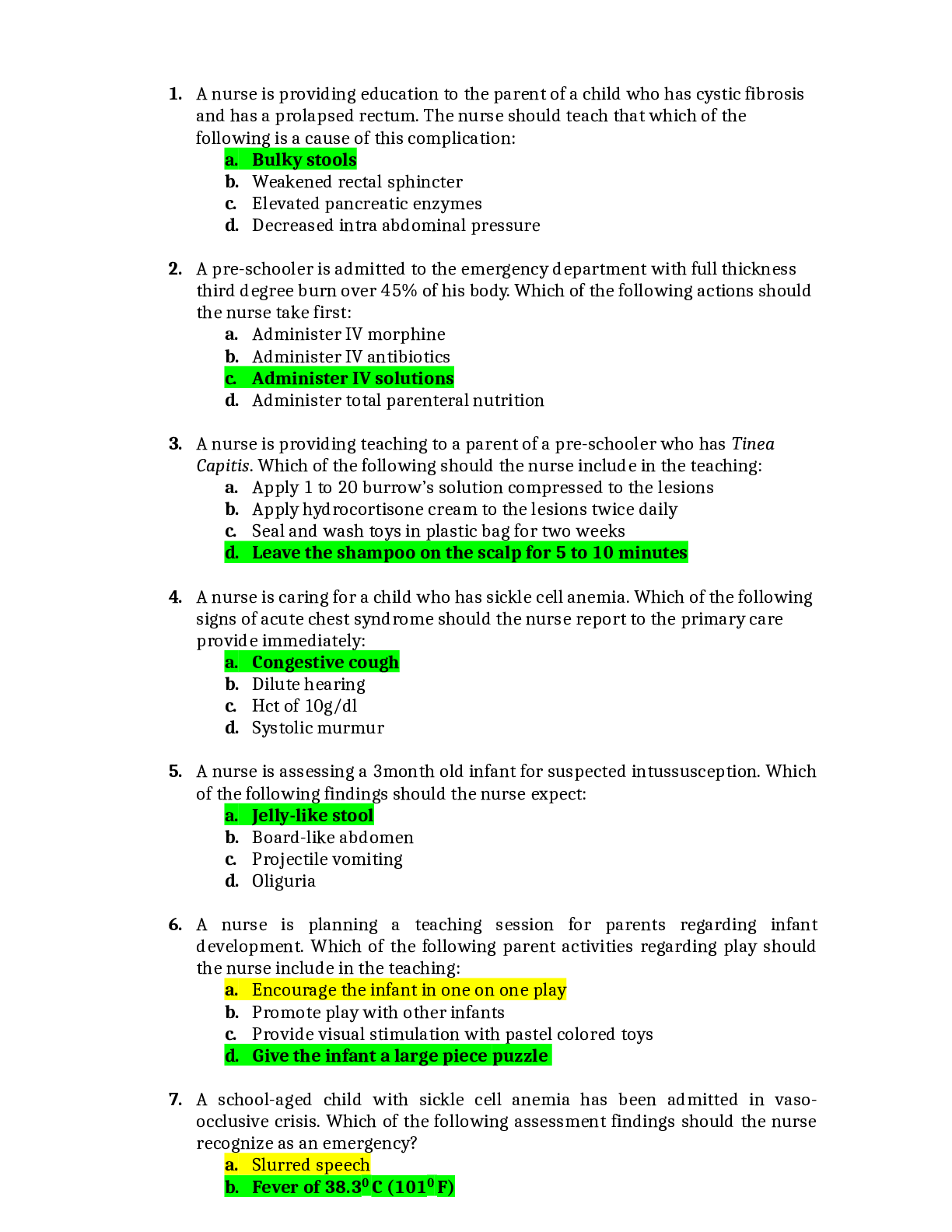


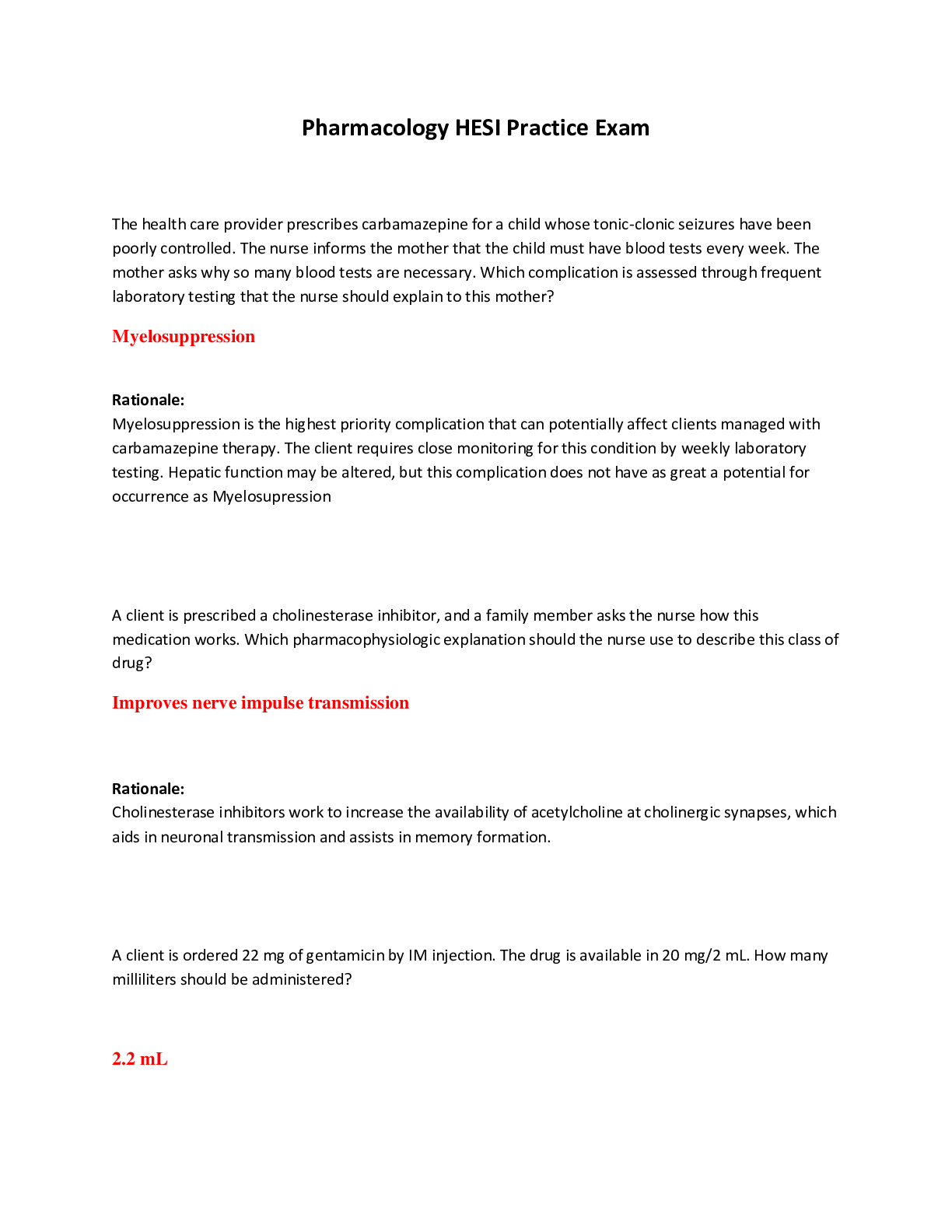




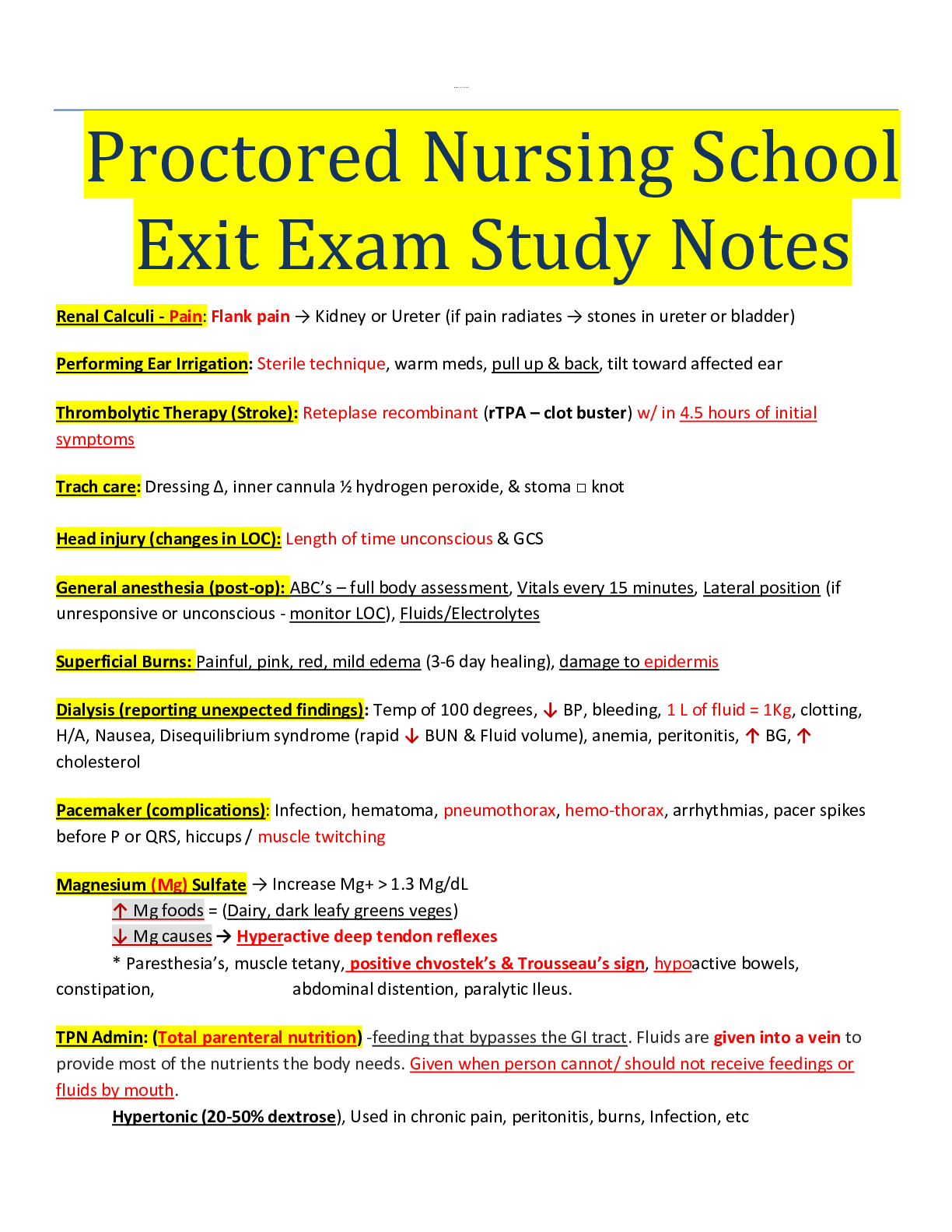
.png)
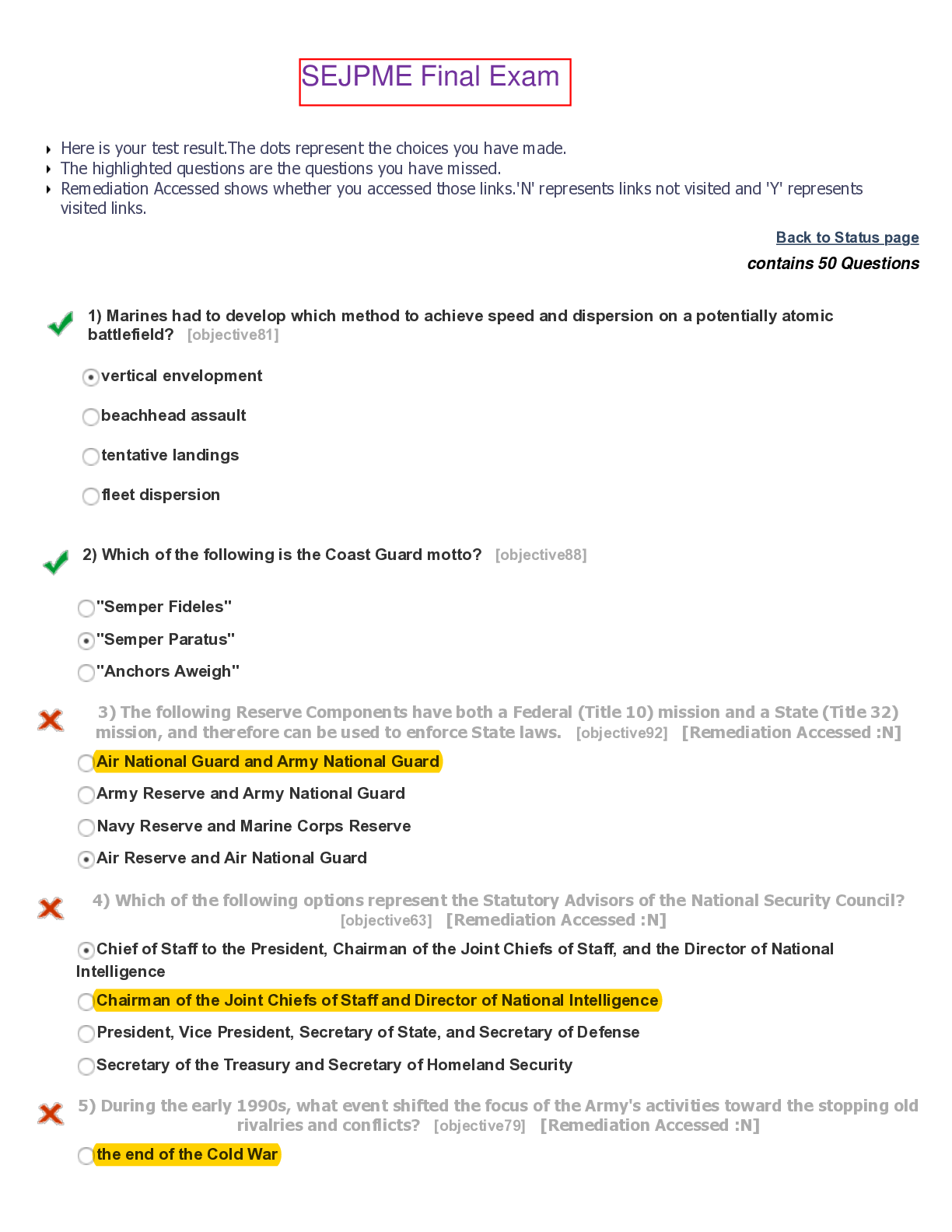
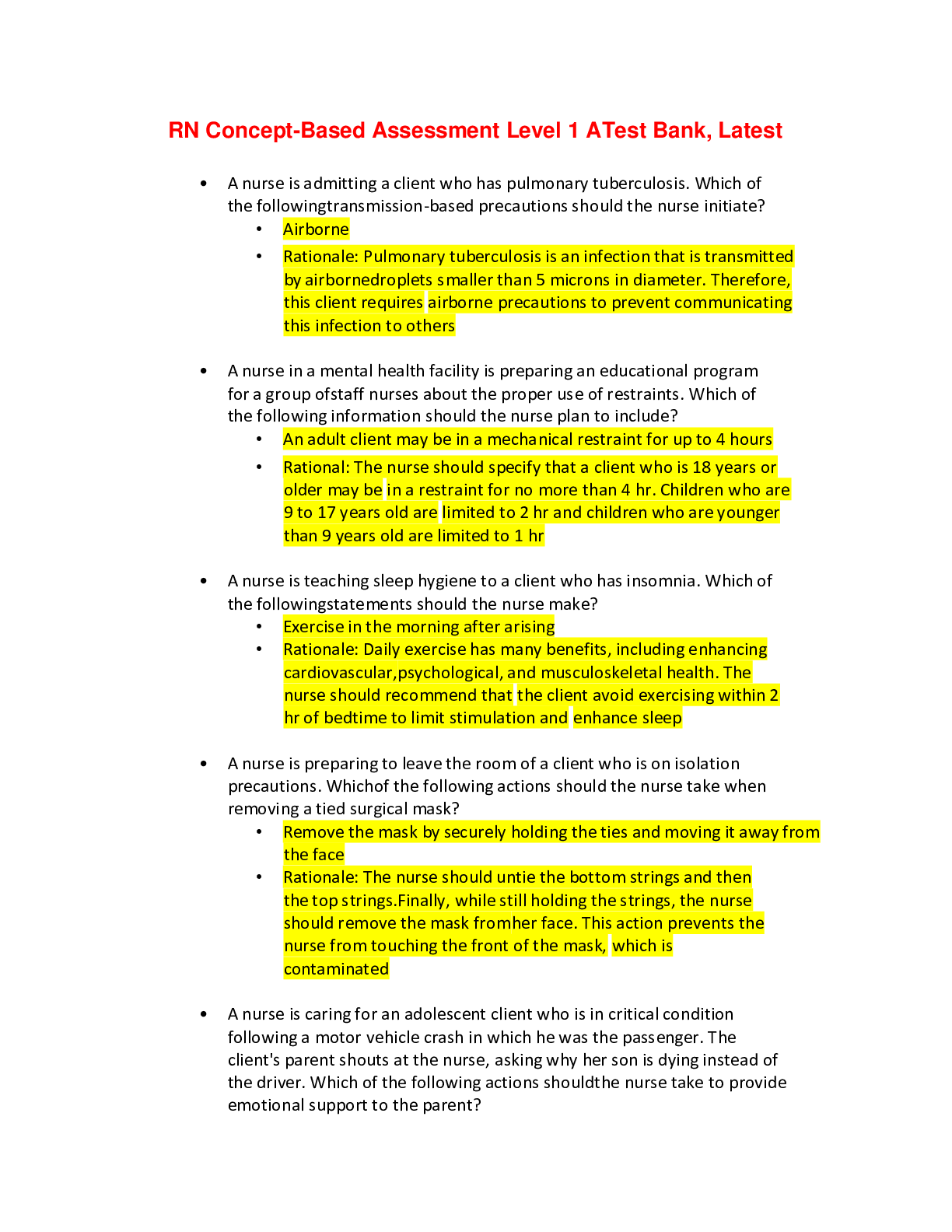
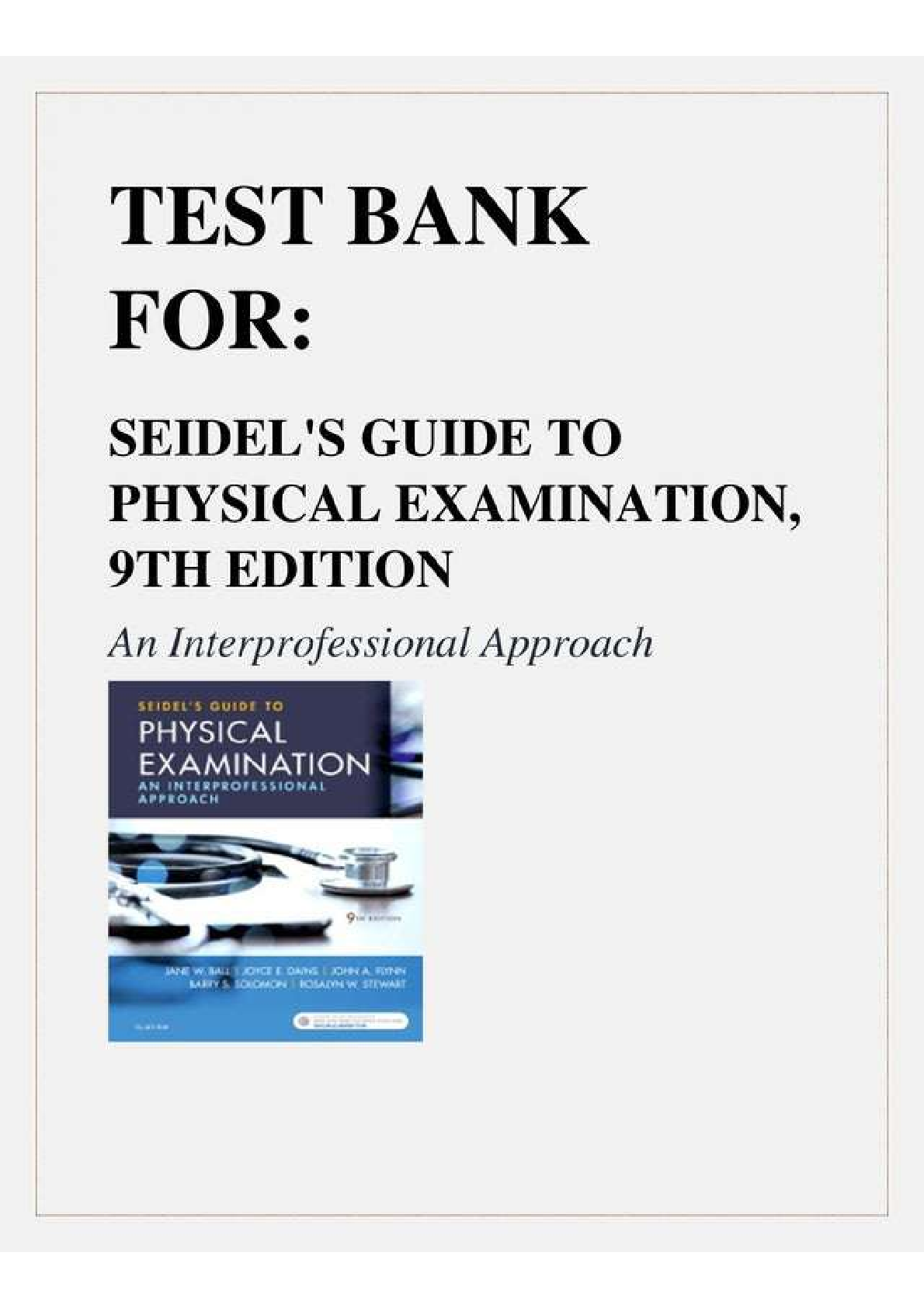

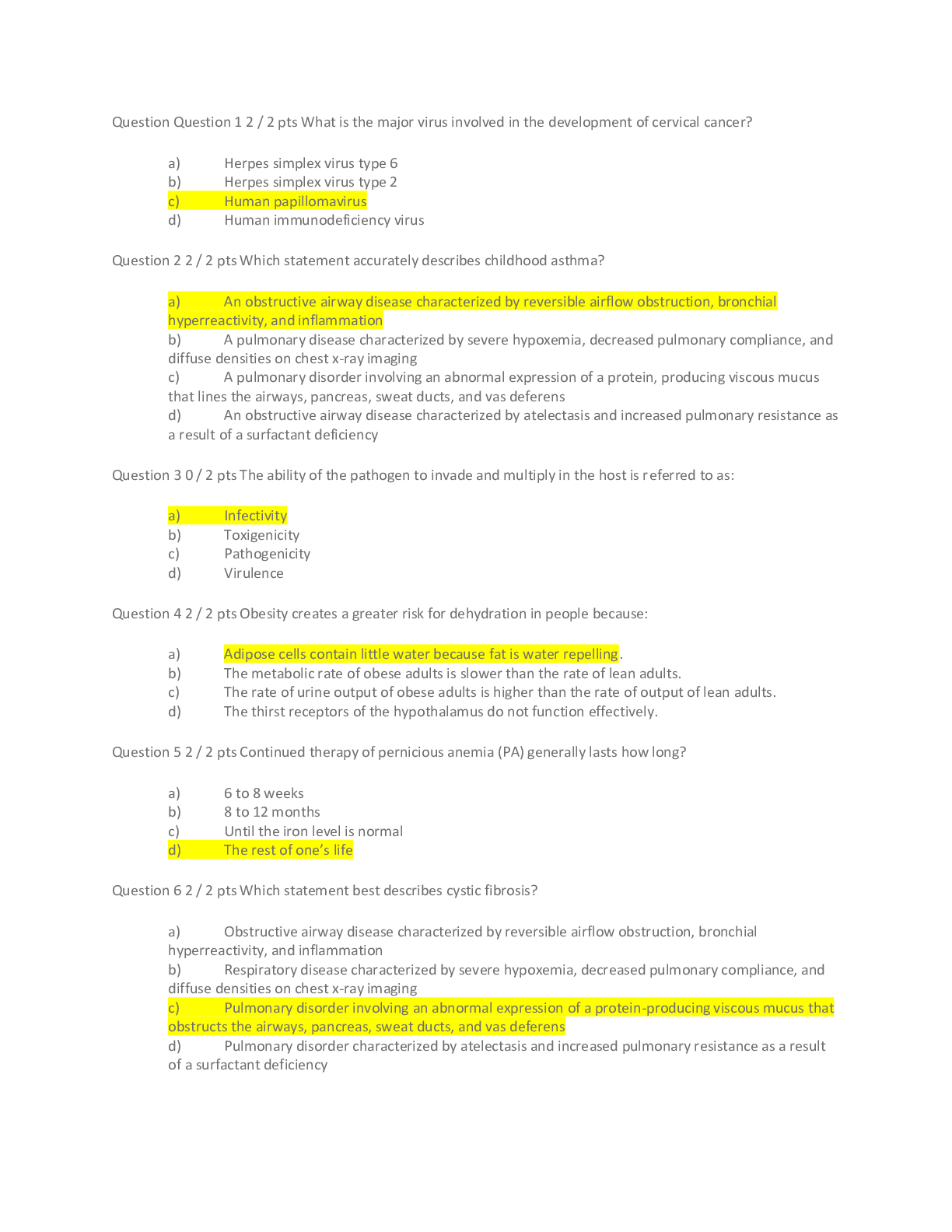
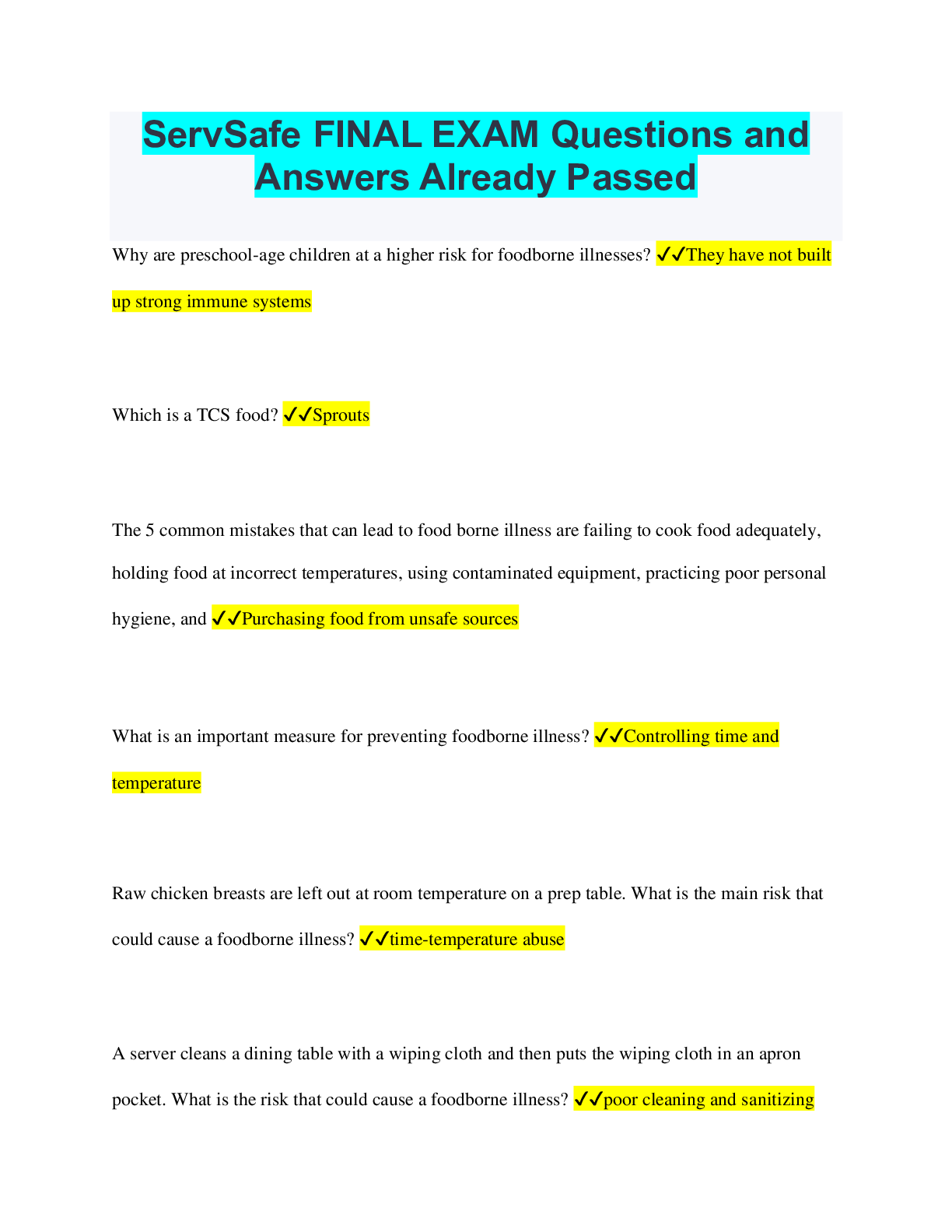



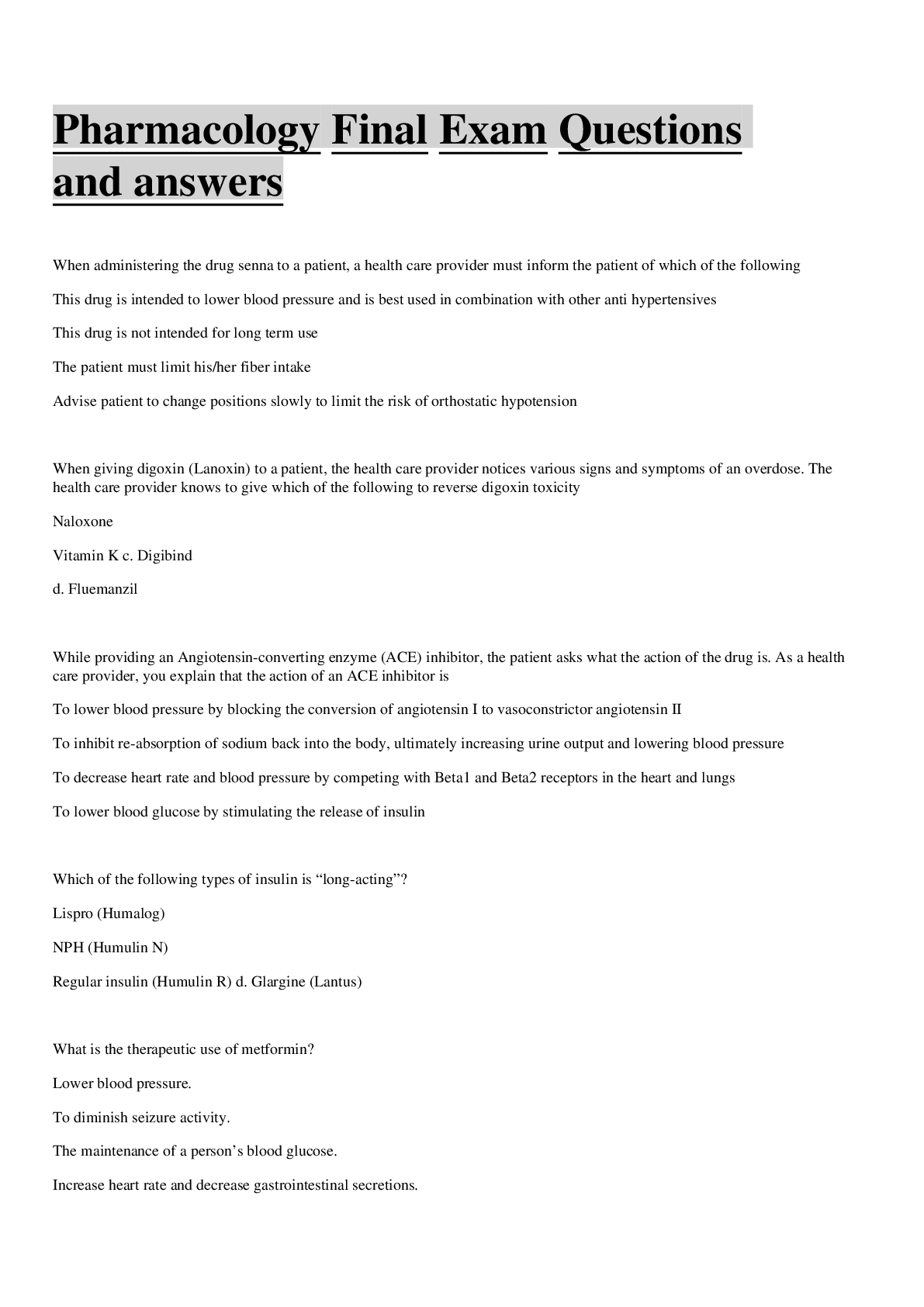
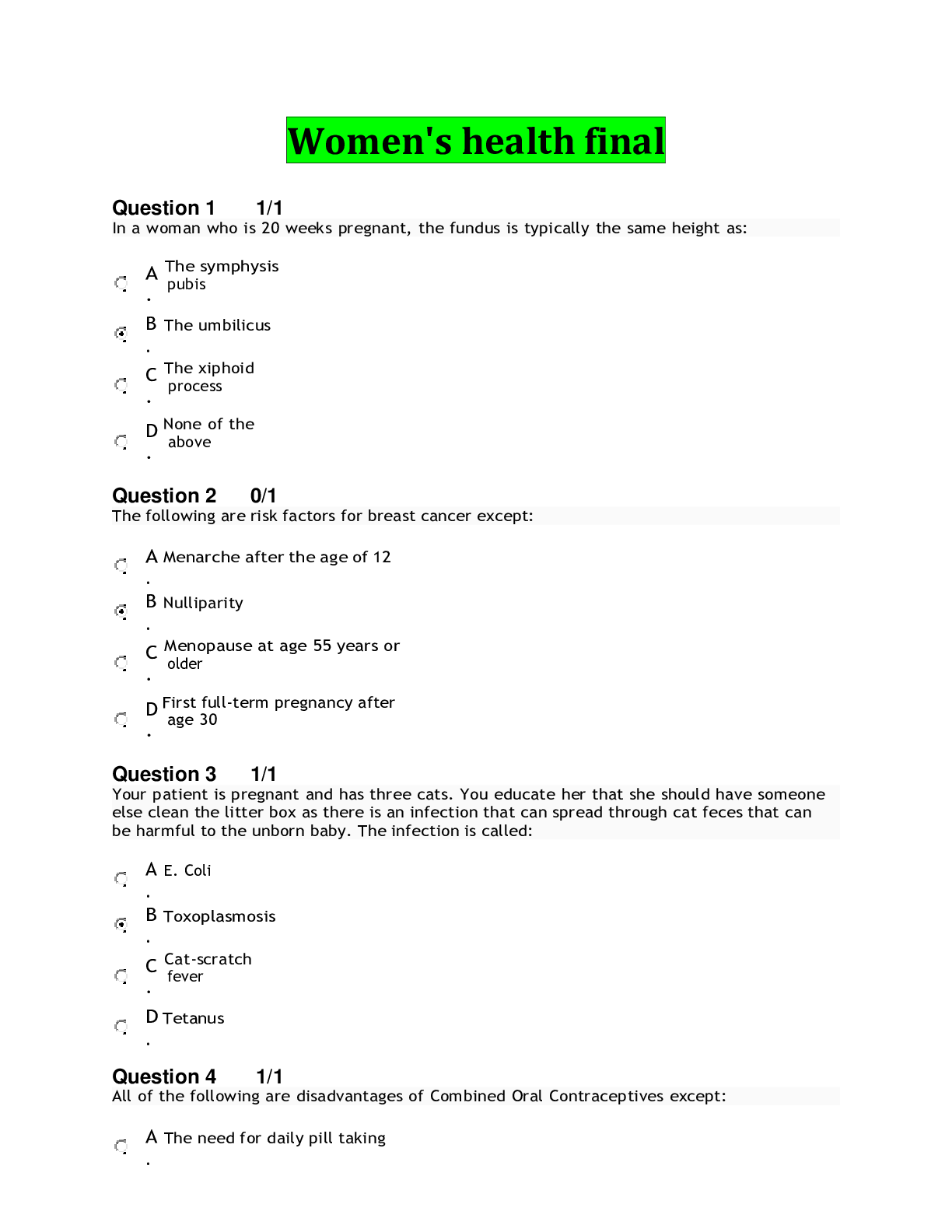


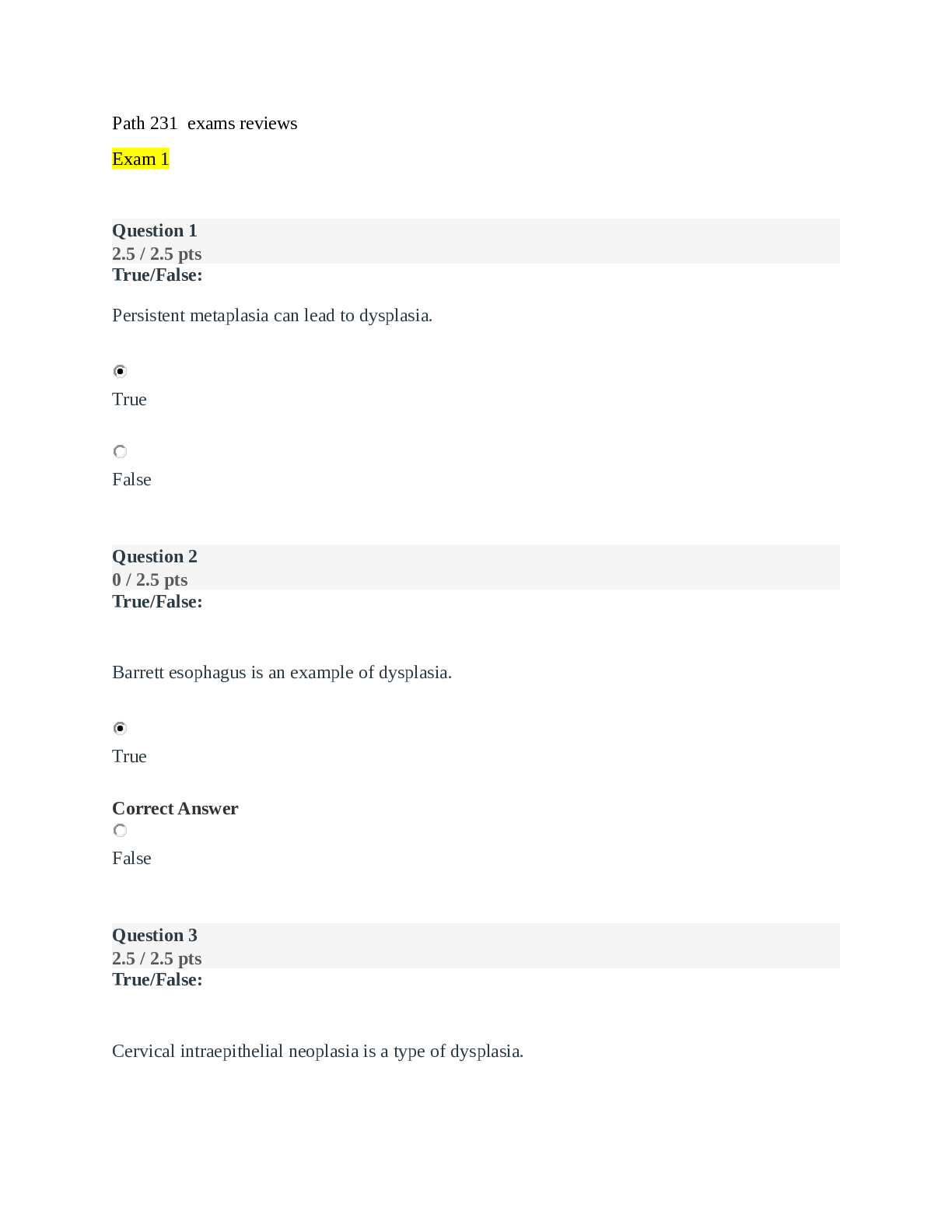
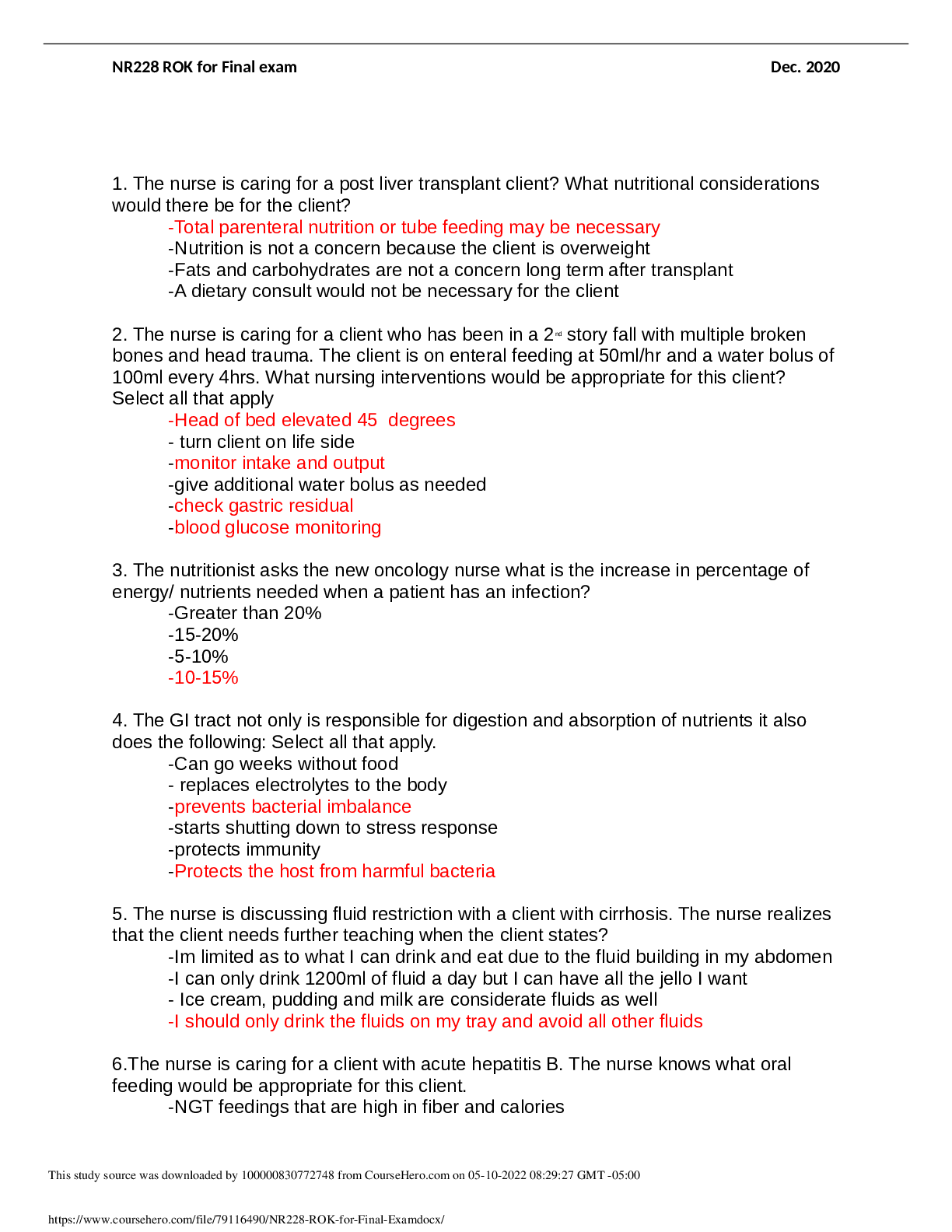

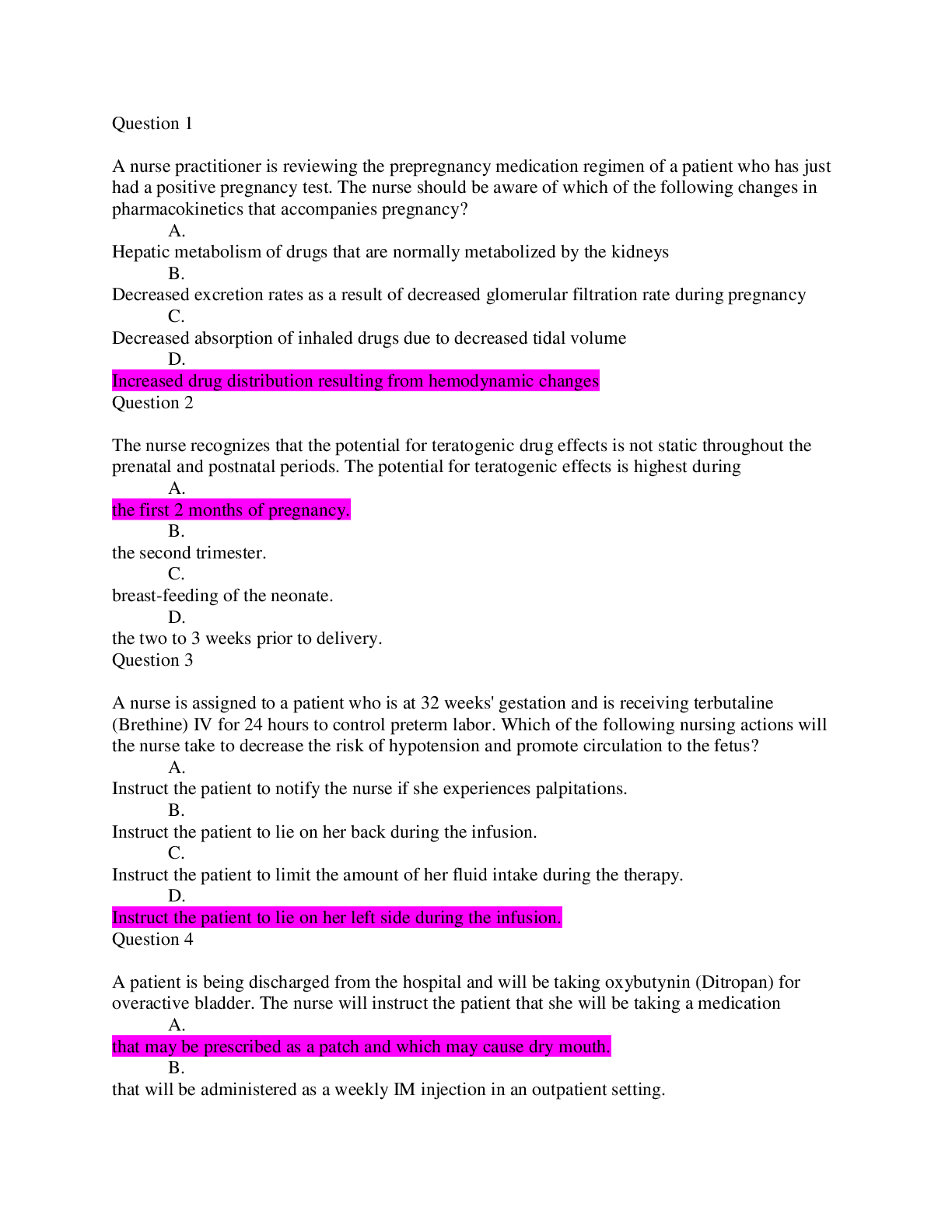

.png)

